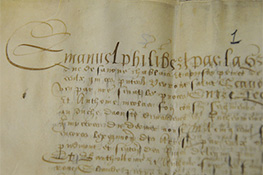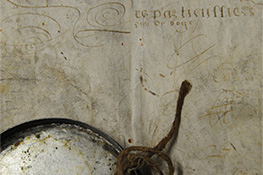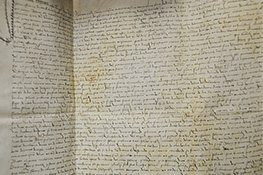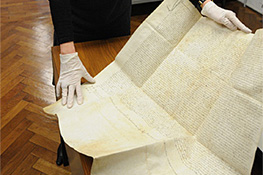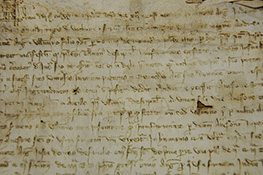Versione italiana English version Version française Versión en español
The parchment, also called sheepskin, can be produced with lambskin (or sheep, goat, calf and other), duly shaved and dried under tension.
It can also be dyed, for example in the early Middle Ages purple parchments were used for writing solemn texts, with particular inks. It takes its name from the city of Pergamum, where it began to be used by the Attalid rulers, in the 2nd - 3rd century B.C. in place of the papyrus. However, its use became common during the Middle Ages, and lasted until the sixteenth century, when it was gradually replaced by vegetable fiber paper.
In the archives of the Historical Library the richest collection of documents produced using this writing support is represented by the collection of the noble Bosses family of Bosses, of Valdostan ancestry.
These are 494 acts dating from the thirteenth to the eighteenth century, of which only two dozen are printed, the others are a collection of parchments dating mainly from the time period between 1200 and 1500.
The lords of Bosses originated from the Valdostan family of the lords of Gignod; their family split into two branches, extinct between the eighteenth and nineteenth centuries. The documents preserved concern both the Bosses and other families related to them by relationships or kinship, and deal mostly with felonies, and then investiture of land to vassals; the territory concerned goes from the area of Aosta to Canavese (Ivrea, Castelnuovo, Bairo, Lorenzè, Strambino) to Valsusa (Chianocco, San Giorio, San Didero, Bruzolo). Many are written in Gothic, French and Latin.
Among the Aostane parchments is the oldest document, a notarial deed of donation and usufruct dated 1225. Of great interest are the Statutes of Chianocco, drawn up by the City Council and approved by Pietro de Chignin, ducal squire and lord of the place, on 19th March 1481.
Interesting is a sentence of Emanuele Filiberto of Savoy, issued in Chambéry on 14th June 1564 on a case between two members of the Bosses family, for the presence of a red wax seal in a tin case (not intact), and some papal bulls, including a dated 30th June 1598 of Clement VIII, who two years later condemned to the stake Giordano Bruno.
- Archive inventory (pdf 531 KB)

